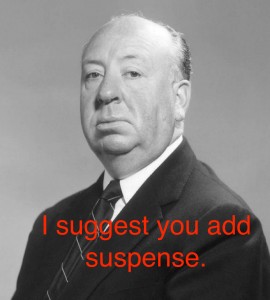“Every novel needs a narrative engine, a reason for people to keep reading to the end, whatever the subject, style, genre or approach.” —Lee Child
Something was missing from my romance. Through prayer and research, I realized I hadn’t created enough suspense in my story.
Although many others exist, these suspense-adding techniques ignited me with new excitement in my story. Consider where in your story you might add one.
1. Have Character 1 lead Character 2 someplace. Character 2 doesn’t know where they’re going or the reason or purpose. The destination can be sinister, but not necessarily.
Make sure what waits Character 2 is a worthy payoff for the reader. Something the reader and character don’t expect. Also, add plausible obstacles that delay them from reaching the destination. This ups the anticipation, as the reader waits for the pay off.
Example: The hero leads the heroine to a magazine editor’s office. She thinks she’ll get her first article assignment. The elevator is full, so they take the stairs. Once inside, her sister, whom she thought was dead, rushes to embrace her.
2. Have Character 1 tell Character 2 his plans. It could be a threat, a scheduled truth-revealing meeting, or a plan to confront someone. The reader will have delicious anticipation or angst knowing the event is ahead.
Example: The hero tells the heroine he’ll be at Marcelle’s Café at 3 p.m. He’ll reveal why he left her at the altar.
3. Have a potential disaster set up in an earlier scene. Make sure it’s memorable and the consequences important enough to make the reader worry it’ll happen. And, of course, it does.
Example: The heroine throws the positive pregnancy test in the trashcan. Garbage day is tomorrow and her husband, who doesn’t want children, won’t return until the day after. The reader could worry that the husband will come home early, the heroine will forget to take the trash out, or another person in the household will wander in and see the pregnancy test.
4. Have the reader expect an event to happen, but it doesn’t occur. Then have the same expectation, but make it the character who now expects it to happen. Again, it doesn’t materialize. On a third time, let the feared event occur, but worse than the reader or character expected.
Example: The babysitting heroine checks that the stairway child guard is secure and leaves the hero’s toddler to put the clothes in the dryer. She returns and the tot is playing with his toys. Then the heroine runs to retrieve her ringing cell, and hears a noise. She races to the child to find him happily banging a toy hammer on the floor. When the kitchen timer beeps, she leaves to remove a pie from the oven. When she returns, the child’s clothes lie on the floor, but he’s gone.
5. Have the character face a potentially unpleasant situation alone.
Example: The heroine housesits her aunt’s cottage. She needs time alone to decide whether she can trust the hero with her heart. She sees ominous headlights approach the cottage. It’s the hero’s stalking ex-girlfriend come to confront the heroine.
Ways to add suspense and get excited about your story. Click to tweet.
How have you added suspense to ordinary situations?






 RSS - Posts
RSS - Posts



0 Comments